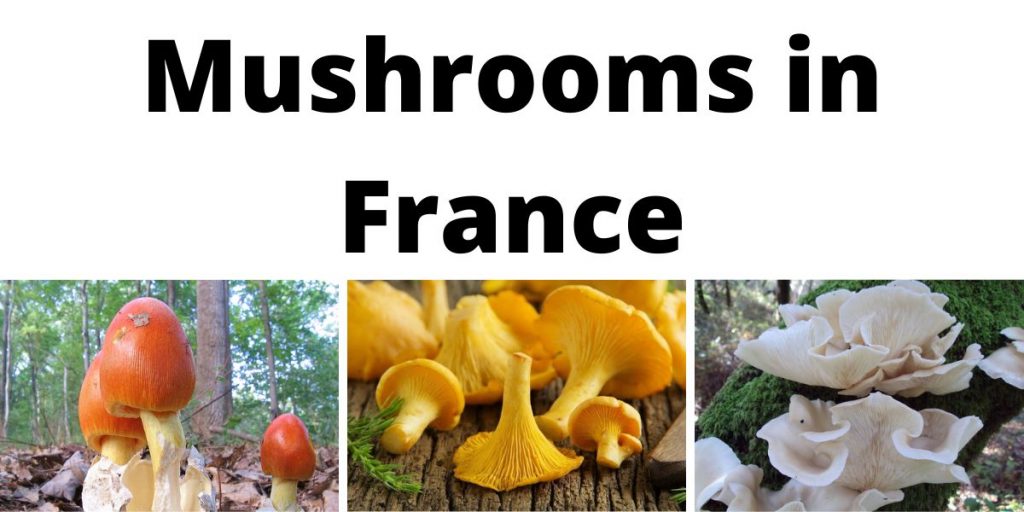France—technically, “metropolitan France,” that portion of the nation that is in Europe and contiguous—has a very varied geography and hence many different mushroom habitats. Plus, the country has a culinary tradition that appreciates many different kinds of mushrooms[i][ii]. Many of these species sound quite familiar to American mycophiles, and indeed there are mushrooms found both in North America and Europe. But there are also many species once thought to have been common to both but actually distinctive of Europe. Americans must now adjust to new taxonomies as we discover what fungi we actually have. Go to France, though, and the old, familiar mushroom names are there. They have the species for which ours are look-alikes.
This account cannot be anywhere close to complete, but should give a sense of what mushroom life is like in France.
The following list does not contain enough information for proper identification. That is deliberate. Mushroom identification, while in most cases not really difficult, is a learned skill, and it can’t be learned in a day from an introductory article. What an article can do, however, is make the incredible variety of edible wild mushrooms seem a bit more accessible—so you’ll have a reason to learn a new skill.
The purpose of this list is solely educational and it is not meant to replace a field guide, spore prints, or an identification app. It is strongly advised to seek guidance from an expert in person if you plan to go mushroom hunting. Additionally, it is crucial to bring a high-quality knife and a basket or bag.
Edible Mushrooms
Mushrooms
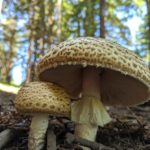
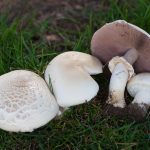
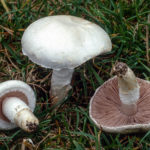
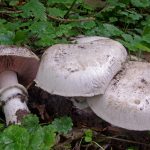
This whole article is about mushrooms, but before the word “mushroom” was used to refer to basically all macrofungi fruiting bodies, it had a more specific meaning and referred to that species whose white buttons you buy in the grocery store—that’s why it seems those things have no common name. Their common name is actually “mushroom.” So it seems reasonable to refer to the close wild relatives of this species as mushrooms in this same, narrow sense. Not all such mushrooms are safe to eat, and many are easy to mix up with toxic species, but a good many are edible.
The Prince (Agaricus augustus) is probably the best of the bunch, hence the name. The Horse Mushroom (Agaricus arvensis) is also choice, although it can concentrate heavy metals, so should not be eaten to excess. The Field Mushroom (Agaricus campestris) is probably the closest to the domestic version and varies from white to brown. The Pavement Mushroom (Agaricus bitorquis) has the remarkable talent of being able to come up through compacted soil or even through literal pavement. It’s not especially tasty, though, and mushrooms sprouting through roadways are likely to be contaminated.
Edible Amanitas
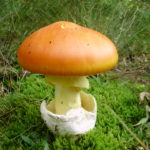
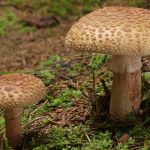

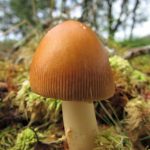
Most experts recommend never eating any Amanita, since some are dangerously poisonous, and so a mistake in identification could have dire consequences. Nonetheless, edible members of the genus do exists.
Caesar’s Mushroom (Amanita caesarea), so called because one or more of the Roman emperors were fond of it, is red-caped but generally without spots. It’s traditionally eaten in the egg stage, when it looks almost exactly like the closely-related deathcap at the same age. According to legend, one of the Caesars was actually murdered that way. The Blusher (Amanita rubescens) bruises red when cut, but otherwise is easy to mistake for other species, one of them poisonous. The Grisette (Amanita vaginata) is a pretty little gray-brown mushroom. The word comes from a slang term for young, working-class French women, who at one time wore gray dresses. The Tawny Grisette (Amanita fulva) is oddly named, for it isn’t gray, but the two grisettes are otherwise similar, and edible but not especially popular.
Boletes
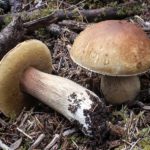
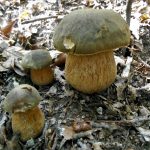
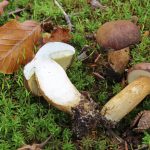
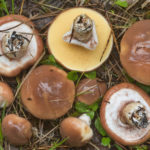

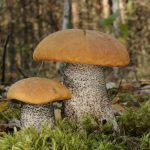
Boletes have the classic, umbrella-like mushroom shape, but instead of gills they have a flat layer of pores on the underside of the cap. They are all related to each other (unlike many other mushroom groups, where shape is not a clue to relatedness) but they are divided into many different genera—and the taxonomy is very much in flux, so that some species have been moved to new genera multiple times in recent years, and others will doubtless be changed again, soon. Common names are more consistent in some cases. Not all are safe to eat, but many are. Some are choice. Following is a small sample of their diversity.
Perhaps the best-known, and certainly one of the best-tasting, is The King Bolete (Boletus edulis), also known as penny bun, cep, or porcini. Closely related and equally good is The Bronze Bolete or Queen Bolete (Boletus aereus)[iii]. The two can be used interchangeably in recipes, though the latter has firmer flesh.
Bay Bolete (Imleria badia)[iv] is also similar-looking and almost as good to eat.
In contrast, members of the Suillus genus, such as Slippery Jack (Suillus luteus)[v] and Weeping Bolete (Suillus granulatus)[vi], tend to be slimy-skinned, not very tasty, and able to give some people mild gastric upset. However, at least there’s lots of them, for when they fruit, they produce large groups.
The Orange Birch Bolete (Leccinum versipelle)[vii] can indeed have an orange cap, though sometimes it is more of an orangish brown. It makes for pretty good eating.
Chanterelles and Trumpets and Kin
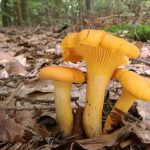
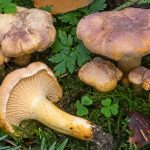
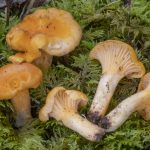
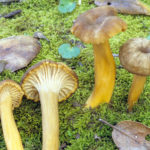



The chanterelles are a group of closely-related mushrooms that lack a clear distinction between cap and stem—the stem simply flares out like end of a funnel. Rather than gills, they have ridges on the outside of the flared part. All are edible (though they do have poisonous look-alikes), and they vary in flavor from good to truly excellent. While Cantharellus is normally considered the chanterelle genus, there are members of other genera that are so similar they might as well be included—especially as some species have been moved back and forth between the genera and so have “chanterelle” in their common name. The most consistently chanterelle-like of these is Craterellus, whose members are often referred to as trumpets.
The Golden Chanterelle (Cantharellus cibarius) is the original bearer of the name, the one people mean if they just say “chanterelle” without otherwise specifying. It is large, yellow, and reportedly one of the best-tasting mushrooms in the world. The Amethyst Chanterelle (Cantharellus amethysteus)[viii] is identical in taste and similar in appearance to the golden, except it has a purplish tinge on the top. The Orange Chanterelle (Cantharellus friesii)[ix] is smaller and varies in color from yellow to orange-red. It’s quite rare. Trumpet Chanterelle (Cantharellus tubaeformis) is small, thin, and brownish yellow, becoming grayer brown with age. Itoften fruits in huge groups. Horn-of-plenty (Craterellus cornucopioides)[x] is blackish and nearly hollow. Being a Craterellus, its flesh is thinner and drier than that of Cantherellus species, and its ridges are reduced to subtle wrinkles. Reportedly, it makes a lovely sauce.
Another genus has spines, rather than ridges, on its underside, but it is related to the chanterelles and has a very similar flavor. The Wood Hedgehog Mushroom (Hydnum repandum)[xi] and The Terracotta Hedgehog Mushroom (Hydnum rufescens)[xii] are quite similar to each other, except for a slight difference in color and size.
Oyster Mushrooms
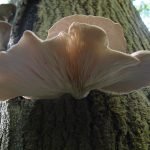
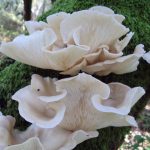
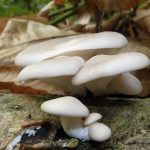
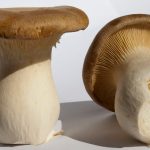
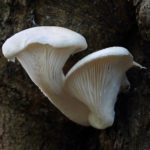
Gray Oyster (Pleurotus ostreatus) is best-known of the several oyster mushroom species, so named because some of them look a bit like oysters. They don’t taste oyster-like. Pale oyster (Pleurotus pulmonarius)[xiii] is similar except it fruits in warmer weather. Branched oyster (Pleurotus cornucopiae)[xiv] has two or more caps per stem. The King Trumpet Oyster (Pleurotus eryngii) is the largest of the group, with a thick stem attached to the center of a small cap. Veiled Oyster (Pleurotus dryinus)[xv] is distinctive both for its whitish top and its partial veil, remnants of which are sometimes visible in mature specimens.
Brittlegills

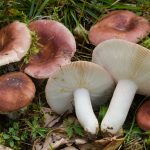
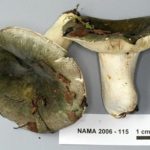
Brittlegills are the members of the genus, Russula. Most do, indeed, have brittle gills, and they have brittle flesh generally to varying degrees. While some are mildly toxic or simply unpalatable, some are choice edibles. Unfortunately, many brittlegills are variable and difficult to identify.
The Charcoal Burner (Russula cyanoxantha)[xvi] is a good example, for its cap can be virtually any color—purple, red, blue, green yellow, gray, or some mixture of any of the above. This species is distinctive in that while the flesh of the stem is extra-brittle, the gills are not brittle at all. The flavor is reportedly nutty and mild. The Flirt (Russula vesca)[xvii] is also variable in color, but the cap is usually reddish to buff with tinges of various other colors. The best way to identify the flirt involves chemical tests. It’s considered a choice edible. The Green-Cracked Brittlegill (Russula virescens)[xviii], not to be confused with the green brittlegill, is relatively easy to identify, however, since its green or greenish cap appears cracked—these are not breaks in the skin but a network of pale lines. The color, not the skin, is cracked. This mushroom, too, is considered choice.
Truffles
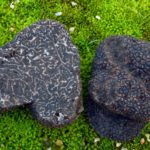
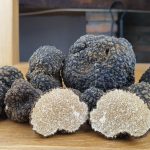
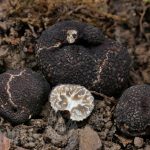
Truffles are essentially underground puffballs, though their texture is very firm. Rather than releasing their spores, they rely on animals to eat them and then distribute the spores (nicely fertilized) in droppings. To attract animals, truffles produce a lovely scent. They are reportedly delicious. Humans value them so highly that truffles are too expensive to be eaten whole and are instead used in small quantities to flavor food. Note that although the word “truffle” is casually applied to other underground fungal structures, true truffles are underground fruiting bodies of the genus, Tuber.
The Périgord Truffle (Tuber melanosporum)[xix] is considered among the best. Its exterior surface is blackish to black and somewhat rough. Its interior is dark but marbled with white. The Summer Truffle (Tuber aestivum)[xx] is not quite as good but still excellent. Its interior is white when young but darkens to gray-brown marbled with white. (Tuber brumale)[xxi] often grows spontaneously in périgord truffle plantations, where it is considered something of a weed, despite being delicious in its own right.
Poisonous Mushrooms
Most mushrooms are not poisonous, and few of those that are represent any real danger. The usual symptoms of mushroom poisoning are mild. But there are some important exceptions. There are also species that are only poisonous sometimes, or for some people. There are species that are safe to eat when cooked but poisonous when raw or that become poisonous when old, and there are other complications. The smart thing to do is to pay as much attention to the poisonous species as to the edible ones—especially since many poisonous mushrooms are fascinating and lovely in their own right.
The following list is not exhaustive. Please don’t assume that a mushroom is safe to eat just because you don’t see it here.
Poisonous Amanitas
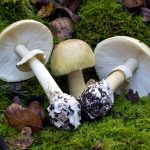
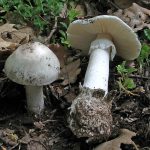
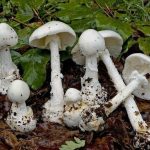

Not all Amanitas are deadly, and some are safe to eat if properly cooked, but it’s good to know the deadly ones are out there—they are a big part of the reason why proper identification is so important for foragers. Deathcap (Amanita phalloides) may have the distinction of having killed more humans than any other mushroom, in part because, according to legend at least, it has been used as a murder weapon. It’s a large, handsome mushroom with a greenish-brown cap. Fool’s Mushroom (Amanita verna)[xxii] and Destroying Angel (Amanita virosa)[xxiii] are both similar in shape and similar, if not greater, in toxic potency, but are entirely white or whitish.
Fly agaric (Amanita muscaria) has the red cap with white spots. It probably won’t kill you, and if properly processed can be used as a psychedelic, though its effects are not the same as those of psilocybin mushrooms. But even under ideal circumstances it has heavy side effects. Make a mistake in processing, and you’ll regret it.
Fool’s Webcap (Cortinarius orellanus)
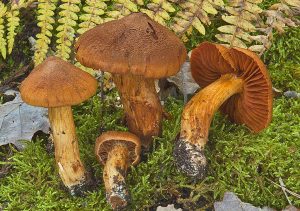
This mushroom[xxiv] is orangish and smells of radishes. It is sometimes mistaken for golden chanterelle—the resemblance is not at all close, but people seem to get exited about the possibility of finding chanterelles. The same common name is also applied to several other similar, and similarly dangerous, species. Its toxin causes kidney damage. With proper treatment, poisoning victims can recover, but recovery is not easy, quick, or certain.
Livid Pinkgill (Entoloma lividum)

Livid pinkgill[xxv], despite the name, is white or whitish. It is sometimes mistaken for various edible species. People who eat it seldom die of is, but do experience serious and long-lasting gastrointestinal problems and pain.
Jack O’Lantern (Omphalotus olearius)
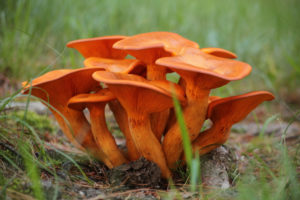
Jack O’lantern is well-known for being poisonous, for glowing in the dark, and for looking like golden chanterelles. The glow is very faint, the resemblance is very slight, but the poison is quite real. Victims don’t usually die but do get very sick.
Magic Mushrooms
Psilocybin, the active ingredient in psychoactive mushrooms, is illegal to use or possess in France, but as of this writing penalties for personal use are not severe[xxvi]. Still, it’s usually best to avoid legal trouble. The following list is not exhaustive, both for the same reason the other lists aren’t, and because it specifically omits species that are not normally used and are therefore not known to be safe. Psilocybin is a relatively safe substance, as mind-altering substances go (not that there is no risk), but the presence of psilocybin is no guarantee that other, more dangerous, substances are not also present.
Be aware that psilocybin-containing species tend to be small, brownish, and non-descript, making them very easy to mix up with several equally non-descript poisonous species. Foraging for wild mushrooms is no job for a novice forager, and that goes for people familiar with magic mushrooms as users. People have died from eating what they thought were magic mushrooms.
Panaeolus
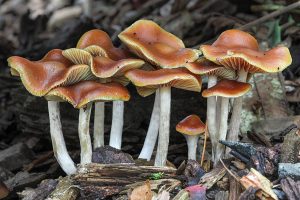
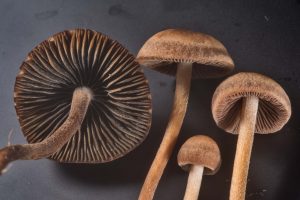
The members of the Panaeolus genus are often called mottlegills because their spores develop in irregular patches, giving their gills a mottled appearance. Some mottlegills are psychoactive, some are not. Those that are psychoactive species vary substantially in potency. Blue Meanies (Panaeolus cyanescens) is one of the most potent psychoactive species known. The Banded Mottlegill (Panaeolus cinctulus), in contrast, is only weakly active.
Psilocybes
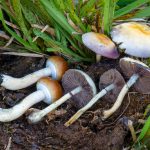
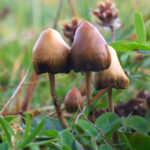

This genus is famous because it contains one of the most widely-cultivated psychoactive mushrooms in the world, Psilocybe cubensis, which does grow wild in the warmer parts of France. The even more potent Liberty Cap (Psilocybe semilanceata)[xxvii] prefers the cooler parts. Blueleg Brownie (Psilocybe cyanescens)[xxviii] is present as well, though it’s likely an accidental import from North America.
References:
[i] André, A. (2021). Watch Out! The Dangers of Mushroom Foraging in France. Annie Andrė
[ii](n.d.). List of Fungi of Metropolitan France. Wikipedia
[iii](n.d.). Boletus aereus Bull. Ex Fr. –Bronze Bolete. First Nature
[iv](n.d.). Imleria badia (Fr.) Vizzini –Bay Bolete. First Nature
[v](n.d.). Suillus luteus (L.) Roussel –Slippery Jack. First Nature
[vi](n.d.). Suillus granulatus (L.) Roussel –Weeping Bolete. First Nature
[vii](n.d.). Leccinum versipelle (Fr. & Hök) Snell –Orange Birch Bolete. First Nature
[viii](n.d.). Cantharellus amethysteus (Quèl.) Sacc. –Amethyst Chanterelle. First Nature
[ix](n.d.). Cantharellus friesii. Wikipedia
[x](n.d.). Craterellus cornucopioides (L.) Pers.–Horn of Plenty. First Nature
[xi](n.d.). Hydnum repandum L.–Wood Hedgehog. First Nature
[xii](n.d.). Hydnum rufescens Pers.–Terracotta Hedgehog. First Nature
[xiii]Jenny (2022). Phoenix Oyster Mushrooms: Identification and Foraging. Mushroom Appreciation
[xiv](n.d.). Pleurotus cornucopiae (Paulet) Rolland—Branched Oyster. First Nature
[xv](n.d.). Pleurotus dryinus (Pers.) P. Kumm.—Veiled Oyster. First Nature
[xvi](n.d.). Russula cyanoxantha (Schaeff.) Fr.–Charcoal Burner. First Nature
[xvii](n.d.). Russula vesca Fr.–The Flirt. First Nature
[xviii](n.d.). Russula virescens (Schaeff) Fr.–Greencracked Brittlegill. First Nature
[xix](n.d.). Tuber melanosporum Vittad.–Périgord Truffle. First Nature
[xx](n.d.). Tuber aestivum Vittad –Summer Truffle. First Nature
[xxi] TUBER BRUMALE Vittadini Monographia Tuberacearum 37, Tab. I fig. VI (1831)
[xxii]Yilmaz, I., Kaya, E., Sinirlioglu, Z. A., Baram, R., Surmen, M. G., Colakoglu, S. (2014). Clinical Importance of Toxin Concentration in Amanita verna Mushroom. Toxicon: Official Journal of the International Society on Toxinology. September (87) 68-75.
[xxiii](n.d.). Amanita virosa (Fr.) Bertill.—Destroying Angel First Nature
[xxiv](n.d.). Cortinarius orellanus Fr. –Fool’s Webcap. First Nature
[xxv](n.d.). Entoloma sinuatum (Pers.) P. Kumm.–Livid Pinkgill. First Nature
[xxvi] Dubley, P. (2023). France & Psychedelics: Moving in the Right Direction? Tripsitter
[xxvii](n.d.). Psilocybe semilanceata (Fr.) P. Kumm.—Liberty Cap First Nature
[xxviii](n.d.). Psilocybe cyanescens Wakef.—Blueleg Brownie First Nature

